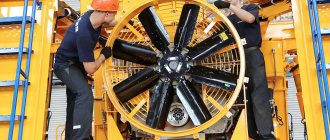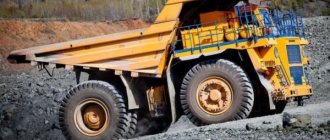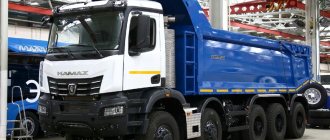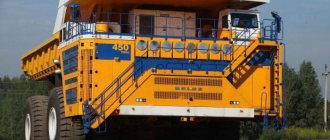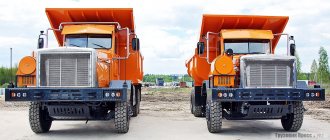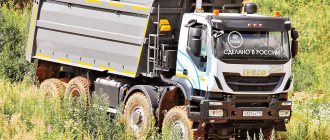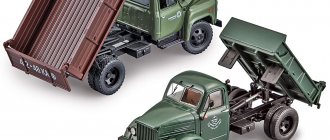Technical characteristics of the BelAZ-7558E electric dump truck
The first experimental model of the BelAZ electric dump truck was created at the end of 2022 on the basis of a 90-ton serial dump truck from the BelAZ-7558 family. These dump trucks are equipped with a diesel-electric power plant with an electromechanical AC transmission. The new BelAZ-7558E model is distinguished by the fact that instead of a diesel generator, the energy source is traction batteries from the Korean company Enertech International. The multi-ton batteries, some of the heaviest in the world, are located between the wheels of the dump truck. Their technology is lithium-nickel-manganese-cobalt-oxide, the capacity is 675 kWh, the output is 640 kW.
The photo of the electric dump truck shows that green is used in its design. In this way, the company emphasizes the environmental friendliness of its equipment, which for the first time does not have a diesel engine for BelAZ products.
The estimated cruising range of the BelAZ-7558E electric dump truck is 2 hours when loading 90 tons and driving up a 10% slope. Charging the battery takes 20-25 minutes.
Note that the description of the BelAZ-7558E electric dump truck does not mention the possibility of energy recovery (obviously, this is due to the need to solve a number of technical problems in the transmission). But the publications of BelAZ leaders talk about this. In particular, Nikolai Viktorovich Bigel, deputy chief designer of STC BelAZ writes:
“... in the mining industry there are enterprises where cargo is transported from top to bottom. This allows for deeper charging of the battery due to recuperation while moving downhill with rock. A preliminary assessment shows that there may be situations where a battery charged at the beginning of the operating cycle is enough for the entire shift, with subsequent charging during a crew changeover or during a lunch break. In such a case, we can talk not only about the environmental effect, but also about possible economic efficiency.”
You can see the practical implementation of recovery in a 60-ton Swiss electric dump truck eDumper in our material: An electric vehicle that does not consume electricity
Everything has already been invented before us and has been working for a long time. Why do more?
BelAZ - (Belarusian Automobile Plant) produces dump trucks, but it often purchases components such as diesel and electric transmission from other organizations.
It is beneficial for BelAZ to have several equipment suppliers in order to stimulate competition, try new design solutions and have insurance in case of supply failure from one of the manufacturers. Nowadays, electric transmissions for BelAZ vehicles are already manufactured by many companies, such as Siemens (Germany), General Motors (USA), a branch of OJSC Power Machines (Russia), such companies (Belarus), Ruselprom (Russia) and ... “we” are trying their hand.
We are an association of several companies, in this project led by ZAO PTFC ZTEO, a transport equipment plant located in Naberezhnye Chelny. At this plant, electric motors and a generator for our transmission are manufactured and tested, power converters and software are made by Moscow and NPF VECTOR, and the design of traction motors is carried out at MPEI University.
Since we have experience in developing electric transmissions for other vehicles, a decision was made and agreements were established to make an electric transmission for BelAZ. The agreement with the dump truck manufacturer was simple: make your own transmission for one vehicle. If it works and doesn’t break down during operation, they will buy more from us. If not, then they won’t even pay for the development and production of this equipment. We decided what to do.
This is how a dump truck with our set of traction electrical equipment (KTEO) was born. At the same time, the first version of our equipment was installed on a used dump truck as part of its overhaul. The old electric transmission was removed from it “for spare parts”, and our new one was installed there. All replacement and installation of wiring, docking to the existing equipment of the dump truck and modification of the software to suit the nuances of a particular machine are at the expense of the contractor.
Prospects for the BelAZ-7558E electric dump truck in the line of 90-ton dump trucks
Testing of the electric 90-tonne truck should be completed in 2022, and mass production is scheduled to begin in 2023. The cost of the BelAZ-7558E will be 4 million rubles of the Republic of Belarus - equivalent to about 1.28 million euros. Annual expenses will decrease by 178 thousand. rubles per year (about 57 thousand euros). Savings are achieved due to the lower cost of electricity compared to diesel fuel and reduced equipment maintenance costs.
The BelAZ-7558 line includes a lot of different modern equipment with thousand-horsepower diesel engines Cummins QST 30-C and KTA 38-C, transmissions Elektrosila, Ruselprom, Tatelektromash, Sibelektroprivod and General Electic. For the launch model BelAZ-75581, which has been in operation at Russian enterprises since 2013, a high CTG (technical readiness coefficient) of 0.92-0.98 has been confirmed.
In development are the BelAZ-75589 dump trucks with a Weichai 12M33 engine, the BelAZ-75588 with a gas turbine engine, the purely electric BelAZ-7558E we discussed, and the BelAZ-7558G diesel trolley truck. The use of these new dump truck models will allow BelAZ customers to optimize their costs.
Cabin BelAZ‑75710
The cabin of the largest BelAZ resembles the control room of an ocean liner, both in its high location and in its abundance of various instruments and sensors. Everything necessary for the safe operation of the dump truck in normal mode is concentrated here. By the way, the top platform of the dump truck, on which the cabin is located, is called the deck.
Driver's workplace BelAZ-75710.
The level of driver comfort is at the level of modern European standards, and there is no talk of any damage to the driver’s health when working on the BelAZ-75710. Even in the most difficult and severe climatic conditions. The driver’s workplace of the largest BelAZ will, of course, be simpler than in a passenger Mercedes, but equipped with everything necessary. The seat is equipped with all adjustments, the cabin has climate control and a modern audio system.
What does KTEO look like?
The set of traction electrical equipment (KTEO) includes two traction motors installed in the wheels of the dump truck, a power generator connected to the diesel engine, and a control cabinet in which, in fact, there are transistor converters. Another option may include a cooling system, a separate top-level controller, some kind of display panel for the driver, software for the technician’s laptop to diagnose all this equipment. This is what it all looks like:
On the top left is a generator, on the bottom is one of the traction motors, on the bottom on the right is a cabinet with converters, and above it is a radiator for the cooling system. On the top right is a high-level controller with a small diagnostic console.
All this junk must have the dimensions and connecting connectors required by BelAZ in order to be inserted into the existing current design of the dump truck.
Dry technical characteristics of our kit
— Rated power of the traction generator, kW: 750 — Rated power of the traction electric motor, kW: 320 — Rated power of the braking resistive installation, kW: 2x600 — Rated rotation speed of the traction generator, rpm: 1900 — Maximum torque on the traction motor shaft: 8490 — Nominal efficiency of the traction generator, %: 95 — Nominal efficiency of the traction electric motor, %: 94 — Cooling of KTEO units: air Generator GST-850 is a classic synchronous generator, with two three-phase stator windings, power 850 kW (mode S6), rated – 750 kW (mode S1). In the GTS-850 there is no third harmonic winding, since the field winding (OW) is powered using an field winding converter (FW) directly from the direct current link (DCL).
DVIT-320 – switched reluctance motor with independent excitation, with three three-phase stator windings, power 320 kW (mode S1), operation with maximum torque in the rotation speed range 0...286 rpm, operation with constant power on the shaft - 380... 4050 rpm
The SHU B-90 control cabinet is structurally composed of three monoblocks housed in one housing.
Braking resistors can also be included in the kit, although they are usually the same type for all manufacturers. They look like this:
The orange section is the resistors themselves (insulators and a high-temperature tape stretched between them), and the round barrel is a motor with a fan. So the braking resistor is like a big hair dryer. In this case, the fan motor is DC, and it is connected in parallel with the braking resistor. It turns out that as the voltage across the resistor increases, the fan speed also increases, which is very convenient. The air flow from such a resistor with a power of 1 MW does not burn at all, but is very pleasant, especially in cold weather. Only the fan at full power is extremely noisy.
How difficult and how long does it take to make such a feasibility study?
From scratch, without experience, of course it’s unrealistic.
We took on this because we have already made similar solutions, we already have experience in designing converters, motors, we have mastered software for control controllers, etc. Those. for us, in fact, this was another option for assembling what we already know how to do. But since the design is new in one way or another, during the testing and commissioning process a myriad of problems still emerged that required all sorts of improvements, both hardware and software. But this will be discussed in more detail in the next article. Development took approximately two years. From the moment we started talking about the project until the dump truck rolled out of the workshop under its own power. This is actually a very fast pace. However, traveling is, of course, not enough. The most important thing is how the machine performs in operation. What kind of “childhood” diseases will there be, what kind of “adult” ones, what will be the service life of the equipment: only time will tell. Now the car has covered about 20,000 km and continues to be used.
And as a little advertisement
This project was carried out mostly by MPEI graduates.
If you want to learn more about electric drives, hybrid transmissions, electric drive control systems and all auxiliary equipment, to study the microprocessor tools used in the industry, then we inform you that the Department of Automated Electric Drive (AED) of the National Research University "MPEI" is recruiting for a master's degree in the direction of 04/13/02 " Electrical power engineering and electrical engineering”, training program – “Electric drive and automation”. More details - under the spoiler
You can enroll in a master's program in this specialty on a competitive basis using a budget-funded form of education or on a paid basis without competition. Nonresidents are provided with a hostel. The training program of the Department of Electrical Engineering can be found on the website of the National Research University MPEI. More information about the admission rules, deadlines for submitting documents and conducting entrance tests can be found on the website of the admissions committee of the National Research University MPEI.
The Department of Automated Electric Drive of the National Research University "MPEI" is the leading department in this specialty in Russia, has more than 20 million rubles. annual volume of research work, publishes more than 20 articles per year in publications indexed by the scientometric databases Web of Science and Scopus, the department is taught by employees of NPF VECTOR LLC and NPP CICL+ LLC - one of the leading enterprises in areas of development of electric drives and hybrid electric transmissions.
More details here: www.aep-mpei.ru
Control system
How is all this hardware controlled?
Each converter has its own controller. A controller in this terminology is a board based on a microcontroller (processor with memory and peripherals on a chip) and its hardware. The hardware usually includes a clocking and power supply system, operational amplifiers for ADCs, buffer chips for discrete inputs and outputs, and communication interface drivers. Controllers are usually made more or less universal and are installed, depending on the task, in some base board, which already contains everything else for implementing a specific device. All controllers are connected via an industrial CAN network. Why CAN? Firstly, it is automotive standard; secondly, it is quite fault-tolerant and undemanding to cables, and thirdly, there are only three wires.
Our implementation of KTEO uses 5 controllers. Two on the traction motors, one on the generator converter, one on the brake resistor converter, and one as a high level controller in the cab.
Oscillator and Resistor Controllers
As a generator controller and a braking resistor, we use this product, a board based on the Texas Instruments TMS320F2810 motor-control microcontroller with a frequency of 150 MHz and 64 kW of flash memory.
In fact, from the point of view of the task of managing the converter keys, such a controller has nothing to do there - an Arduino, pardon the expression, could handle it. However, these controllers also poll a bunch of temperature sensors, implement some logic to control the fans and pumps of the unit, participate in network exchange via CAN, measure the generator rotation speed, etc. Therefore, to speed up development time and for unification with other manufactured equipment, it was decided to use such redundant, but time-tested controllers.
Traction motor controller
Things get more interesting with controllers for traction motors.
Since the traction motor of a mining dump truck must produce high torque at low and zero rotation speeds, this requires designing the motor and converter for high phase current when using a conventional three-phase motor winding. And many other manufacturers do this, obtaining an amplitude phase current measured in kiloamperes. This entails difficulties in laying such a cable (as thick as a leg), expensive IGBT switches, and a low switching frequency of such switches. When designing this machine, we took a different route and made a 9-phase motor. Those. it has three independent shifted three-phase windings. This allows you to reduce the current load on each wire and key, and make the converter stackable, from similar low-power keys. However, from the point of view of the control system, the task becomes more complicated: you need to control 18 inverter switches simultaneously with one controller! And additionally two keys for the excitation winding. Moreover, since the electrical machine is single, and the three-phase windings are inductively coupled, it is impossible to divide the task into several controllers - synchronization is required between all PWM timers that control the switches. The figure below shows the structure of the traction motor converter.
Thus, a microcontroller was needed with at least 18 PWM outputs (the excitation winding, due to its large inductance, can be controlled without using PWM, by programmatically opening and closing the keys in relay mode), a bunch of ADCs, and a rotor position sensor (RPS) interface. And we have already written about such a microcontroller. This is a domestic microcontroller K1921VK01T based on an ARM core and a frequency of 100 MHz. It just has 18 PWMs, and everything else for controlling the motors. Therefore, we used it in the controller, since there are not many reasonable alternatives.
By the way, to control traction motors, vector control, slightly modified for the multiphase case, is used, the principles of which are described in detail in this article, and the free version of the software, taken as the basis for development, is here.
This is what an open control cabinet with installed controllers looks like. Here on the left is a block of a braking resistor and a generator with two controllers next to each other, then the blocks of the right and left traction motors. The power switches are located in the depths, and the base board with controllers installed in it and some power buses are visible from the outside.
Top Level Controller
As a top-level controller, a separate controller was developed (for this and other similar projects) based on two Texas Instruments TMS320F28335 microcontrollers. Why two? Firstly, this device has a lot of discrete and analog I/O, you need a lot of legs, and secondly, for some tasks we needed three CAN interfaces (for different subnetworks of the car), and the microcontrollers we have mastered have only two. However, specifically in the dump truck project, the second crystal is not used (not soldered).
On the board, among other things, you can see a slot for a micro SD card - there the KVU stores all the logs (all network exchange) in a circle, erasing the old ones. Therefore, the KVU also performs the functions of a “black box”.

